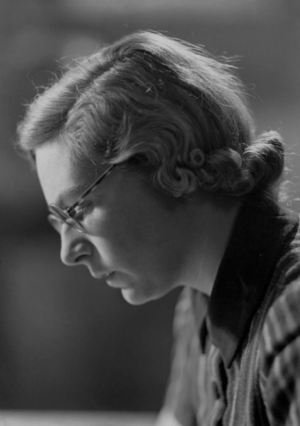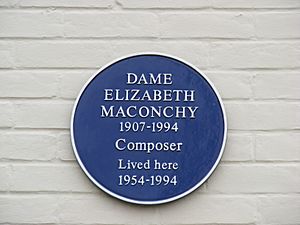Elizabeth Maconchy facts for kids
Quick facts for kids
Elizabeth Maconchy
|
|
|---|---|

in 1938 by Howard Coster
|
|
| Born |
Elizabeth Violet Maconchy
19 March 1907 Broxbourne
|
| Died | 11 November 1994 |
| Nationality | United Kingdom |
| Education | Royal College of Music |
| Occupation | composer |
| Spouse(s) | William LeFanu |
| Children | two |
Dame Elizabeth Violet Maconchy LeFanu DBE (born March 19, 1907 – died November 11, 1994) was a very talented composer from Ireland and England. Many people think she was "one of the best composers the British Isles have ever had." She wrote over 200 pieces of music during her life.
Contents
Biography
Early Life and Education
Elizabeth Violet Maconchy was born in Broxbourne, Hertfordshire, England. Her parents were Irish. She grew up living in both England and Ireland. In 1917, when she was 10, her family moved to Howth, a town on the east coast of Ireland.
Elizabeth started learning music in Dublin. She took piano lessons from Edith Boxhill. She also studied harmony and counterpoint, which are important parts of music theory. These years in Ireland were very important to her. She always felt a strong connection to Ireland. People often called her an Irish composer, or an English composer with "Celtic" (Irish) influences.
Studying Music in London
In 1923, at age 16, Elizabeth moved to London. She enrolled at the famous Royal College of Music. There, she studied with important teachers like Charles Wood and Ralph Vaughan Williams. Other talented students at the college at that time included Grace Williams and Ina Boyle.
Even in her early works, like her violin sonata and Piano Concertino from 1927, you could hear the influence of European composers, especially Béla Bartók. Elizabeth won special scholarships that helped her continue her studies in Prague. Her music was first played in public in 1930. Her Piano Concerto was performed in Prague. Later that year, her cantata The Land was played at the famous BBC Proms concert series.
Supporting New Music
It was hard for young composers, especially women, to get their music heard back then. So, Elizabeth and other women composers decided to do something about it. They started organizing their own concerts. These concerts were held at a small theater in London.
This effort was very important. Some people say it "changed music in London." It was a huge help for Elizabeth Maconchy throughout the 1930s. It gave her a chance to share her new and exciting music.
Family Life and Health
In 1930, Elizabeth married William LeFanu. They had two daughters together: Elizabeth Anna (born 1939) and Nicola LeFanu (born 1947). In 1932, Elizabeth became ill with tuberculosis. Because of this, she and her family moved from London to Kent, a county in southeast England.
She returned to Dublin, Ireland, for a short time in 1939. During this period, she wrote her Fifth String Quartet. Some music experts believe this piece is one of her greatest works.
Working for Composers
Elizabeth Maconchy worked hard to make things better for other composers. In 1959, she was chosen to lead the Composers Guild of Great Britain. She held this important position for several years. She also became the President of the Society for the Promotion of New Music.
Elizabeth believed strongly in fairness and equality. She supported causes she felt were right, like helping those fighting for democracy during the Spanish Civil War. Her friends included other famous composers like Elisabeth Lutyens and Grace Williams. Elizabeth once said that for her, "the best music is an impassioned argument." She passed away in Norwich, England.
Compositions
Elizabeth Maconchy is known for her unique and energetic music. She wrote over 200 pieces! Her music has been compared to famous composers like Bartók, Beethoven, and Mozart.
She often used short musical ideas, like small fragments, and built her pieces from them. She liked to explore how different musical intervals (the distance between two notes) sounded together. She also often used both major and minor sounds at the same time. This created moments of strong emotion in her music. Her music is often described as full of "energy, dynamism and imagination" because of its strong rhythms.
String Quartets
Elizabeth Maconchy's most famous works are her thirteen string quartets. These are pieces written for four string instruments: two violins, a viola, and a cello. She wrote them between 1932 and 1983. Many people consider these quartets to be the best of her musical achievements. One music historian said that Elizabeth loved the quartet form because it was like a "debate" or a "discussion" between four equal and passionate voices.
- String Quartet No. 1 (1932/33)
- String Quartet No. 2 (1936)
- String Quartet No. 3 (1938)
- String Quartet No. 4 (1942/43)
- String Quartet No. 5 (1948)
- String Quartet No. 6 (1950)
- String Quartet No. 7 (1955)
- String Quartet No. 8 (1967)
- String Quartet No. 9 (1968)
- String Quartet No. 10 (1972)
- String Quartet No. 11 (1976)
- String Quartet No. 12 (1979)
- String Quartet No. 13 Quartetto Corto (1982–83)
Other Works
Elizabeth also wrote music for voices. In 1943, during World War II, she wrote "The Voice of the City." This piece was for a women's chorus and was about the Battle of Stalingrad. In 1981, she set some poems to music. These were based on sonnets by the Irish writer John Millington Synge, and the piece was called 'My Dark Heart'.
Symphonic Works
These are pieces for a full orchestra or a smaller group of instruments.
- Suite in E minor for string orchestra (1924)
- Fantasy for flute, harp and string orchestra (1926, lost)
- Elegy for flute, horn and string orchestra (1926, lost)
- Fantasy for Children for small orchestra (1927–28)
- Theme and Variations for orchestra (1928)
- The Land, symphonic suite after V. Sackville-West's poem, for orchestra (1929)
- Symphony (No. 1), for orchestra (1929–30, withdrawn)
- Suite for chamber orchestra (1930, withdrawn)
- Comedy Overture for orchestra (1932–33)
- Two Dances from the ballet Puck Fair, for orchestra (1940)
- Variations on a Well-Known Theme, for orchestra (1942)
- Theme and Variations for string orchestra (1942–43)
- Suite from the ballet Puck Fair, for orchestra (1943)
- Symphony (No. 2), for orchestra (1945–48, withdrawn)
- Nocturne for orchestra (1950–51)
- Proud Thames : Coronation Overture, for orchestra (1952–53)
- Symphony for double string orchestra (1952–53)
- Suite on Irish Airs, for small orchestra (1953 ; arr. for full orch, 1954)
- Suite on Irish Airs, version for full orchestra (1955)
- A Country Town, 6 short pieces for orchestra (c. 1956) [arr. of piano pieces from 1939]
- Music for Woodwinds and Brass (1965–66)
- An Essex Overture, for orchestra (1966)
- Three Cloudscapes for orchestra (1968, withdrawn)
- Genesis for chamber orchestra (1972–73)
- Sinfonietta, for orchestra (1976)
- Little Symphony, for orchestra (1980–81)
- Music for Strings (1981–82)
- Life Story, for string orchestra (1985)
Concertante Works
These are pieces for a solo instrument (or a few solo instruments) with an orchestra.
- Andante and Allegro, for flute and string orchestra (1926–27)
- Concertino (No. 1) for piano and chamber orchestra (1928 ; rev. 1929–30)
- Viola Concerto (1937, withdrawn)
- Dialogue for piano and orchestra (1940–41)
- Concertino (No. 1) for clarinet and string orchestra (1945)
- Concertino (No. 2) for piano and string orchestra (1949)
- Concertino for bassoon and string orchestra (1950)
- Toombeola, for violin and string orchestra (1954, withdrawn)
- Concerto for oboe, bassoon and string orchestra (1955–56)
- Suite for oboe and string orchestra (1955–56)
- Serenata concertante for violin and orchestra (1962)
- Variazioni concertante, for oboe, clarinet, basson, horn and string orchestra (1964–65)
- Epyllion, for solo cello and 15 strings (1973–75)
- Romanza for viola, woodwind quintet and string quintet (1979)
- Tribute, for violin and woodwind octet (1982)
- Concertino (No. 2) for clarinet and small orchestra (1984)
Stage Works
These are pieces written for ballets or operas, which are performed on a stage.
- Great Agrippa, ballet (1933)
- Puck Fair, ballet, libretto: F. R. Higgins, (1939–40)
- The Sofa, comic opera, libretto: Ursula Vaughan Williams, (1956–57)
- The Three Strangers, opera, libretto: Elizabeth Maconchy after Thomas Hardy, (1957–58, rev. 1967, −69, −77)
- The Departure, opera, libretto: Anne Ridler, (1960–61, rev. 1977)
- The Birds, extravaganza, Elizabeth Maconchy after Aristophanes, (1967–68)
- Johnny and the Mohawks, children's opera (1969)
- The Jesse Tree, masque, libretto: Anne Ridler, (1969–70)
- The King of the Golden River, children's opera, libretto: Elizabeth Maconchy after John Ruskin (1975)
Honours and Awards
Elizabeth Maconchy received many awards and honours for her amazing music.
- In 1933, her quintet for oboe and strings won a competition. It was even recorded soon after!
- In 1948, she won the Edwin Evans Prize for her String Quartet No. 5.
- In 1953, her overture "Proud Thames" won a competition to be the official Coronation Overture for the new Queen of the United Kingdom.
In 1959, Elizabeth was asked to lead the Composers' Guild of Great Britain. She was the first woman ever to hold this position! In 1960, she received the Cobbett Medal for her chamber music. She was also given special honours by the Queen:
- In 1977, she was made a Commander of the Order of the British Empire (CBE).
- In 1987, she was made a Dame Commander (DBE). This is a very high honour, similar to a knighthood for men.
See also
 In Spanish: Elizabeth Maconchy para niños
In Spanish: Elizabeth Maconchy para niños


